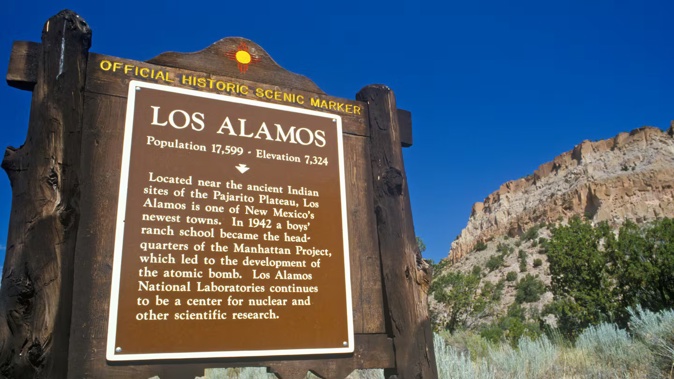
It’s no surprise that the United States site where Robert Oppenheimer tested the world’s first atomic bomb remains radioactive, but what are the implications for the hikers and bikers that still use the popular park?
It’s hard to think of Los Alamos, New Mexico, without remembering the Los Alamos National Laboratory.
The scenic area was popularly known as the place where J Robert Oppenheimer developed the first atomic bomb. The area’s wide space and remoteness provided the perfect testing centre for nuclear devices.
But aside from its convenience, it was rumoured that the father of the atomic bomb really loved New Mexico, so much so that he even wrote to a friend years before the nuclear production: “My two great loves are physics and New Mexico. It is a pity they can’t be combined.”

Robert Oppenheimer (1904-1967), American physicist. Photo / Getty Images
Just like Oppenheimer, people can’t help but fall in love with New Mexico despite its controversial history.
The Acid Canyon, ironically named after its radioactive history, is a popular hiking and biking spot near Los Alamos where nature lovers go for a moderately challenging hike.
Decades after his experiments and great discoveries, new tests suggest that radiation still lingers in the area.
Biochemist Dr Michael Ketterer recently studied the trail and revealed that Acid Canyon’s radioactivity is at an alarmingly high state, posing a threat to communities and wildlife.
In July, with the help of Nuclear Watch New Mexico, Ketterer conducted a series of tests by taking water, soil, and plant samples from Acid Canyon, as well as soil and plant samples in Los Alamos Canyon at the Totavi service station.
The samples were then prepared and studied at Northern Arizona University, where Ketterer measured concentrations of plutonium, a highly dangerous chemical element.

The Chernobyl power plant site in Europe, where a nuclear disaster occurred in 1986, has long-lasting effects from ground absorption of radiation. Photo / 123rf
The results revealed that the areas have very high concentrations of plutonium in the soils and sediments.
Furthermore, his findings state that a portion of the plutonium found in the Acid Canyon is “some of the oldest known Pu contamination in the ambient environment – a portion of which likely pre-dates the Trinity Test itself”.
More alarmingly, Ketterer’s study reveals that the water samples along the trail contained high radioactivity, which can cause a threat to people and habitats.
The dangers of the plutonium in the canyon’s water does not only endanger those who visit the area, Ketterer warns.
The biochemist shared its dangers with the reporters from AP, saying, “It’s just an extreme example of very high concentrations of plutonium in soils and sediments. Really, you know, it’s hiding in plain sight.”
He notes that it is also dangerous for communities and habitats nearby, as the plutonium-laden water and sediment can flow through the Acid Canyon, then into Los Alamos Canyon, and eventually the Rio Grande.
Ketterer warns that the radioactive plutonium in the water can be absorbed by plants, accessing the food chain via green-eating herbivores, or spread airborne through the ashes of common wildfires.

The Acid Canyon welcomes hundreds of visitors every year. Photo / 123rf
A finding in his study concluded: “Of particular concern is the possibility of wildfire in Acid Canyon. The activity concentrations of 239+240Pu in Acid Canyon sediments and plant matter, along with the canyon’s close proximity to residential areas of Los Alamos, represents an alarming potential situation of plutonium releases into the air, should a wildfire engulf the canyon.”
The radioactivity expert warned the public about how serious this issue is since it poses a threat through contamination - something that cannot be fixed simply or cheaply.
Though outdoor enthusiasts can still visit the trail, Ketterer calls for action from local officials to warn visitors to avoid coming in contact with water in the area.
After the release of Ketterer’s study, the United States Department of Energy’s environmental management Los Alamos field office issued a statement to the Associated Press stating the radioactivity levels are “very low and well within the safe exposure range”.
The department assures the surrounding communities and visitors that continued collection and monitoring of sediments and water samples have shown plutonium remains “very low and within the safe exposure ranges”.
Read Dr Michael Ketterer’s full study at nukewatch.org/press-release-item/high-detections-of-plutonium-in-los-alamos-neighborhood/
Take your Radio, Podcasts and Music with you









